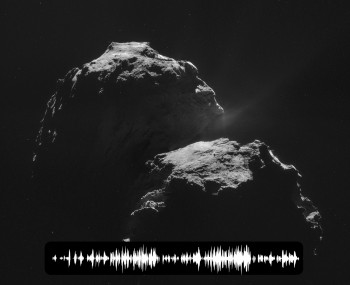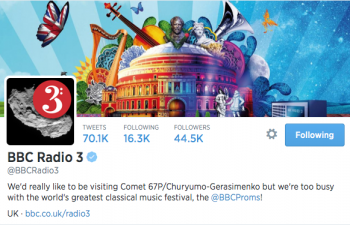This blog post is contributed by Mark McCaughrean, senior science advisor in the Directorate of Science and Robotic Exploration at ESA.
The rather tortured title of this post is intended as a humorous reference to the decidedly non-spherical shape of Comet 67P/Churyumov-Gerasimenko, the target of our Rosetta mission. It also refers to the philosophical concept of ‘musica universalis’ or ‘music of the spheres’, usually attributed to Pythagoras, Ptolemy, and other ancient philosophers and scientists.
They suggested that the proportions of the distances of the celestial bodies in the Solar System thought to be orbiting the Earth could be assigned tones, much as the pitch of a note coming from a plucked string is related to the length of that string.
This theory was later developed further by Johannes Kepler in his works ‘Mysterium Cosmographicum’ (1596) and ‘Harmonices Mundi’ (1619). In these, Kepler proposed that a series of nested regular polygons provided the basis for the proportions observed in the heavens in a Copernican, Sun-centred Universe, and that the geometrical properties of these polygons could be linked to the ‘music of the spheres’.
Kepler’s work on Tycho Brahe’s astronomical data later led him to his famous laws of planetary motion, which describe the elliptical orbits of objects around the Sun; astronomers would later realise that they even apply to the very elliptical orbits of comets like 67P/C-G. It’s interesting to note that one of Kepler’s formative astronomical experiences was seeing the Great Comet of 1577 when he was just six years old. (To read a brief history of comets, please see our earlier blog post “Chasing comets – across history“).
In the theory of the ‘music of the spheres’, the sounds are not supposed to be directly audible. That provides a nice link to the now famous “Singing Comet” as presented and described in earlier blog posts, in which magnetic field data from the RPC-Mag instrument on Rosetta was converted into an audible ‘song’ with the collaboration of German composer Manuel Senfft. The song has been played over 5.6 million times online.
https://soundcloud.com/esaops/a-singing-comet
During 2014, Rosetta has also engaged and inspired people to write music spanning a number of genres. We’ve mentioned some of these in earlier posts, but thought we’d take the opportunity to collect some of those together for your enjoyment and further inspiration as we enter the holiday period over Christmas and New Year.
Earlier in the year, as Rosetta approached 67P/C-G, John Crossley, music producer and programme lead for music production at the University of Derby in the UK, wrote a 45-minute suite simply titled “Rosetta”. Influenced by a wide range of artists from Pink Floyd to Elbow, this suite was performed live on 7 June in full surround sound at the Derby Theatre with his band, Sigma 7, involving students from the university. A documentary, including the full live performance, can be seen on the Syncopate TV YouTube channel, along with stereo and binaural mixes of the seven songs in the suite.
Steve Chowne is an engineer who worked in the mid-1990’s on the software used by Rosetta during its long hibernation period. Inspired by the successful wake-up from hibernation on 20 January, Steve wrote a 12.5-minute orchestral score covering the mission’s main milestones, which was first performed on 29 November by the Redhill Sinfonia, also in the UK. A recording was made of the concert and will be made available soon, but in the meantime, a synthesised version of the work can be heard on SoundCloud:
https://soundcloud.com/steve_chowne/rosetta
One of the more unusual things we did to promote Rosetta and to engage people in the broader scientific and philosophical goals of the mission was to work with the Polish company Platige Image to produce a short science fiction film called “Ambition”, directed by Tomek Baginski and starring Aidan Gillen (Game of Thrones) and Aisling Franciosi (The Fall):
The film has been viewed around 2.5 million times across various channels and an important aspect of its success has been the soaring soundtrack written by Polish-Bulgarian composer, Atanas Valkov. Atanas also wrote the music for the teaser trailer that went out before the film was released on 24 October, and these pieces can be listened to on Atanas’ SoundCloud page:
https://soundcloud.com/atanasvalkov/sets/ambition-ost
Atanas has since been working on a full album of music from the soundtrack and otherwise inspired by Rosetta, including sound samples from ESA’s space science missions, and this album is due to be released on 15 January 2015:
Behind the scenes, we had also been working with Greek musician, Vangelis, famous for his many iconic film soundtracks, including Chariots of Fire, Blade Runner, and 1492: The Conquest of Paradise, in addition to numerous rock albums over the years. Vangelis has long had an interest in space and has worked with NASA in the past on some of their missions. On this occasion, he was inspired by Rosetta and wrote three short pieces for us which were released on 12 November, Philae’s landing day:
Vangelis has since been working on a larger set of compositions related to Rosetta and we are working with him on a project for 2015.
Landing day was a huge event worldwide and many other musicians have since been moved to create pieces about the mission. One of them is Edward Blakeley, a young composer and producer from the UK, who has put together a Kickstarter campaign to fund a full orchestral album called “The Rosetta Suite”. Edward has already put together a sample and this can be listened to on his Kickstarter page and Soundcloud:
https://soundcloud.com/ejblakeley/the-rosetta-suite-liftoff
Further afield, both geographically and musically, composer and pianist Artur Cimirro from Brazil has written four dissonant contemporary piano pieces about Rosetta, which he has gifted to the Rosetta team. Rough first recordings of these pieces can be downloaded and heard here:
Beyond these pieces, many other people have put together music based on Rosetta, some around the wake-up in January and some using the “Singing Comet” sample, for example. A few of these other pieces are listed here, but there’s no way that this post can be exhaustive, and we welcome anyone else inspired by the journey of Rosetta and Philae to write music to contact us, so we can keep a fuller picture:
https://soundcloud.com/thingsfromthepast/wake-up-rosetta-a-ted-roberson
https://soundcloud.com/chiaramusic/deep-space-hibernation-live
https://soundcloud.com/jithin-thomas/if-you-see-me-i-see
You can also listen to a full Rosetta-inspired album by French musician Cedric Leroy, and watch a sneak preview of a very witty song about Philae’s landing on Comet 67P/C-G by physicist-turned-comedian-presenter-and-songwriter Helen Arney, which will feature soon in an edition of BBC Radio 4’s “More or Less”.
And speaking of the BBC, we’re also reminded of the classical channel Radio 3, who adopted Comet 67P/C-G as their Twitter icon during the annual Proms concerts in August.
All of this music has in turn inspired us to think about what we might do in 2015 to continue to promote Rosetta as the mission enters its next exciting phase when Comet 67P/C-G moves closer to the Sun and bursts into spectacular life. In particular, we’re thinking about some kind of event to celebrate Perihelion Day on 13 August, and music may well play a central role in that.
We’ll keep you posted.











Discussion: 2 comments
Thank you very much Professor McCaughrean. Actually I’m a music guy, so looking forward to listening to them.
But the real surprise was Vangelis. Thank you all who have contributed to realise this collaboration! On the landing day I was totally concentrating on what was going on at the comet and the control rooms. Without knowing what was going on on ESA’s Youtube channel. So I think it was more than 24 hours later that I was completely blown away by finding a name “Vangelis” there. Not only 1, not 2, but 3 tunes. And all was fantastic even though they all sounded like fading out in the middle. Looking forward to the full complete forms of them. Thank you!!
I had one more tune that I found and listened to during those days. I think this was introduced in CNES’s Twitter account:
https://www.youtube.com/watch?v=h3nvu6SwvV0
I immediately fell in love with this mood. Far far different from triumphant kind of, optimistic kind of music. But. All alone, unknown world, have no idea what’s waiting, etc, etc. I imagine if there was someone onboard alone, or I should say, if Philae had human heart, this music reflects one of the strong possibilities of how he/she was feeling when descending in the dark.
hello, Thank You for having me added to your blog, I am an artist and composer of musique: my name and Mercurius
I give you my website, internet and my name meter on your blog and information: my artist name is cedric leroy and my website for the link and:
https://eologieproduction.fr.nf/
Eologie Production
My music video
https://www.youtube.com/watch?v=hStJESHBbyI